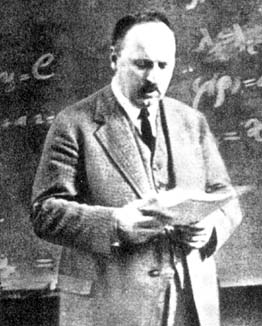


 تاريخ الرياضيات
تاريخ الرياضيات
 الرياضيات في الحضارات المختلفة
الرياضيات في الحضارات المختلفة 
 الرياضيات المتقطعة
الرياضيات المتقطعة
 الجبر
الجبر
 الهندسة
الهندسة 
 المعادلات التفاضلية و التكاملية
المعادلات التفاضلية و التكاملية 
 التحليل
التحليل
 علماء الرياضيات
علماء الرياضيات |
Read More
Date: 31-5-2017
Date: 27-5-2017
Date: 27-5-2017
|
Died: 6 August 1945 in Leipzig, Germany

Paul Koebe's father was Hermann Koebe and his mother was Emma Kramer. Hermann Koebe owned a factory and was able to give his son a good education. Koebe attended a realgymnasium in Berlin. He entered this school in 1891 and there he studied religion, Latin and modern languages, history and geography, and mathematics and science. The course, which was based more on practical applications than that of the more academic gymnasium, still qualified Koebe to enter university.
He studied first at Kiel University which he entered in 1900 but after one semester he moved to Berlin University where he was to study for five years. At Berlin his thesis was directed by Herman Schwarz and his additional examiner for the oral on his thesis was Friedrich Schottky who had been appointed to Berlin in 1902 while Koebe was in the middle of his studies. Between 1904 and 1905 Koebe studied at the Charlottenburg Technische Hochschule, then he undertook research at Göttingen for his habilitation presenting his thesis in 1907.
Koebe was appointed to Leipzig University in 1910 as an extraordinary professor of mathematics. He became an ordinary professor in 1914 when he accepted a position at Jena university. He returned to Leipzig, this time as an ordinary professor, in 1926.
Koebe's work was all on complex functions, his most important results being on the uniformisation of Riemann surfaces. Shortly after 1900 Koebe established the general principle of uniformisation which had been originally conceived by Klein and Poincaré. Koebe's proof of the uniformisation theorem has been described as:-
... arguably one of the great theorems of the century.
The article [5] describes his contributions in some detail and gives a list of 68 publications by Koebe. These are not, however, a collection of great works on a par with his proof of the uniformisation theorem. Koebe's style was pompous and chaotic and Koebe anecdotes were famous in Germany between the two wars. He did make other important contributions, however, and his circle domain conjecture is still being attacked. A special case was proved in 1993 by Z-X He and O Schramm.
Freudenthal writes in [1]:-
He tended to deal broadly with special cases of a general theory by a variety of methods ...
Freudenthal also tells us that Koebe's life-style was, as his mathematics, chaotic. It is unclear from what Freudenthal writes whether he is implying that Koebe required a wife to help organise his life but certainly he had no wife, remaining a bachelor all his life.
Books:
Articles:



|
|
|
|
"عادة ليلية" قد تكون المفتاح للوقاية من الخرف
|
|
|
|
|
|
|
ممتص الصدمات: طريقة عمله وأهميته وأبرز علامات تلفه
|
|
|
|
|
|
|
قسم التربية والتعليم يكرّم الطلبة الأوائل في المراحل المنتهية
|
|
|